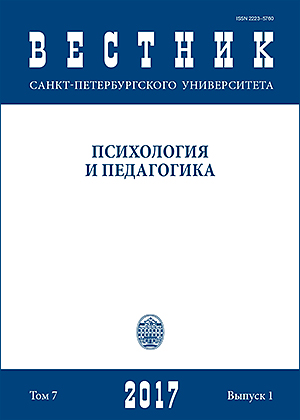Embodied Cognition as a Current Trend in Cognitive Psychology
DOI:
https://doi.org/10.21638/11701/spbu16.2017.102Abstract
The article describes one of the main trends in cognitive psychology — theoretical models associated with the phenomenon of embodied knowledge. We set shortcomings of the classical symbolic approach, the first theoretical approach established in cognitive psychology in 1950–70 years. The main branches of the new trend associated with embodied knowledge are described: grounded cognition, enactivism, phenomenological approach, neo-ecological approach, theory of dynamic systems. The first two of them are characterized in details.
Keywords:
embodied cognition, embodiment, cognitive psychology, grounded cognition, enactivism, theory of perceptual symbols, indexical hypothesis
Downloads
References
target=”_blank”> http:// doi.org/10.1177/1745691613498098
target=”_blank”> http://doi.org/10.1111/j.1756-8765.2010.01115.x
нова, М. В. Фаликман. М.: Ломоносовъ, 2011. 383 p.
target=”_blank”> http://doi.org/10.1006/jmla.2000.2705
target="_blank">https://doi.org/10.3389/fpsyg.2013.00330
Massachusetts: The MIT Press, 2013. 206 p. http://doi.org/10.7551/mitpress/9780262018548.001.0001”
target=”_blank”> http://doi.org/10.7551/mitpress/9780262018548.001.0001
http://doi.org/10.1177/1745691613498098”
target=”_blank”> http://doi.org/10.1177/1745691613498098
http://doi.org/10.3758/BF03196322”
target=”_blank”> http://doi.org/10.3758/BF03196322
http://doi.org/10.1111/j.1756-8765.2010.01115.x”
target=”_blank”> http://doi.org/10.1111/j.1756-8765.2010.01115.x
target=”_blank”> http://doi.org/10.1006/jmla.2000.2714
target=”_blank”> http://doi.org/10.1017/S0140525X99252144
target=”_blank”> http://doi.org/10.1006/jmla.2000.2705
target=”_blank”> http://doi.org/10.1207/s15327868ms1401_6
motor representations in semantic sensibility judgments. Journal of Memory and Language, 1989, no. 28 (1), pp. 56–77.
stimulation of the tongue in the congenitally blind. Brain, 2005, no. 128 (3), pp. 606–614.
system: localisation and object recognition with “The Voice”. Perception, 2007, no. 36 (3), pp. 416–430.
target=”_blank”http://doi.org/10.3389/fpsyg.2013.00330
Understanding the Feel of Consciousness”. Review of Philosophy and Psychology, 2012, no. 3 (1), pp. 89–108.
target=”_blank”> http://doi.org/10.7551/mitpress/9780262018548.001.0001
Downloads
Published
How to Cite
Issue
Section
License
Articles of "Vestnik of Saint Petersburg University. Psychology" are open access distributed under the terms of the License Agreement with Saint Petersburg State University, which permits to the authors unrestricted distribution and self-archiving free of charge.




